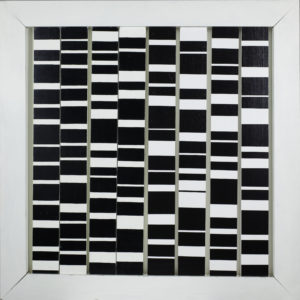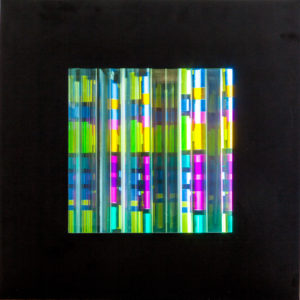Omar Carreño studied at the Escuela de Artes Plsticas y Aplicadas in Caracas (1948-1950), while at the same time attending the Taller Libre de Arte, where he produced some of the first abstract works in Venezuela. Moving to Paris in 1950, he joined Los Disidentes and later exhibited his Polpticos, pictorial planes that, by means of hinges, could be manipulated and transformed by the spectator, at the Galerie Arnaud (1952). He was the only Latin American artist invited to participate at the exhibition organized by Le Corbusier on the occasion of the 9th Congrs International d’ Architecture Moderne (Aix-en-Provence, France, 1954).
Carreo returned to Venezuela in 1955, and during the second half of the 50s he constructed sculptures in iron, among them Estable n 1, the first abstract piece to win an award in the country, on the occasion of the 18th Salon Oficial Anual de Arte Venezolano (1957). He participated with policromas, creating murals for the Facultad de Odontologa (1956-1958), in a project integrating visual arts and architecture led by architect Carlos Raul Villanueva at the Ciudad Universitaria in Caracas. He further developed his lacquer paintings on wood begun in Paris.
At the beginning of the 1960s, Carreo went back to Paris and subscribed to the principles of the Informalista movement. His painting outside geometrical abstraction included a series of works that evoked marine scenes. These were presented at the exhibition El Nereida, at the Museo de Bellas Artes (Caracas, 1965).
In 1965, Carreo traveled to Rome, where he returned to the geometric form. His works from this period, Obras Transformables, were displayed at Galleria d’ Arte Fiamma Vigo in Rome (1966), and, upon his return to Caracas, at the Sala Mendoza (1967). These exhibitions launched the Movimiento Expansionista, led by Carreo and promoted by means of manifestos and the organization of group exhibitions. Fundamentally, expansionism proposed turning to the spectator as a contributor to the transformation of the art work. To do this mechanical and illuminating devices to used to create virtual images, ambiguous spaces, and dynamic structures. Carreo’s Cajas luminosas transformables was an important piece in the Movimiento Expansionista which reached its peak in the exhibition Imgenes transformables (Estudio Actual, Caracas, 1971) and the monumental installation for the36th Venice Biennial (1972).
In 1972, Carreo received the Premio Nacional de Artes Plsticas, in Caracas. He received many awards and was the subject of several retrospectives, including one presented at the Museo Espaol de Arte Contemporneo (Madrid, 1983). His prolific production continued throughout the following decades, returning to his themes of preceding periods producing a new series of Obras transformables, marine motives following an abstract-figurative synthesis, and painting murals focused on geometric abstraction.

